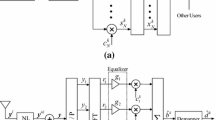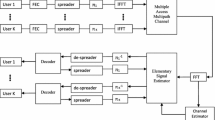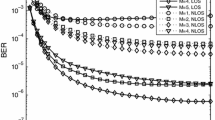Abstract
This paper proposes a novel radial basis function assisted adaptive path selective decorrelating detector for direct sequence code division multiple access systems with time-varying multipath fading channels under impulsive noise. The proposed detector combines adaptive path selective decorrelating detector (APSDD) with a radial basis function (RBF) network to eliminate the effect of impulsive noise. Simulation results clearly show that the proposed detector eliminates the effect of impulsive noise and improves the performance of APSDD under high impulsive noise.





Similar content being viewed by others
References
Zvonar Z (1996) Combined multiuser detection and diversity reception for wireless CDMA systems. IEEE Trans Veh Technol 45(1):205–211
Ulusoy AH, Amca HA, Hacıoğlu K, Rizaner A (2002) A decorrelating detector for asynchronous CDMA channels with adaptive path selection. IEE Proc Commun 149(3):167–170
Ulusoy AH, Rizaner A, Hacıoğlu K, Amca H (2005) Performance analysis of adaptive path selective decorrelating detector with channel estimation errors. Wirel Pers Commun 35(3):321–327
Blackard KL, Rappaport TS, Bostian CW (1993) Measurement and models of radio frequency impulsive noise for indoor wireless communications. IEEE J Sel Areas Commun 11(7):991–1001
Ulusoy AH, Rizaner A (2008) Adaptive path selective fuzzy decorrelating detector under impulsive noise for multipath fading CDMA systems. IEEE Commun Lett 12(4):228–230
Yang SY, Jiao LH, Liu F (2002) A novel multiuser detection method based on IEA-RBF neural network in CDMA. Signal Processing, 2002 6th International Conference on Signal Proc 1(1):62–65
Mitra U, Poor HV (1994) Neural network techniques for adaptive multiuser demodulation. IEEE J Sel Areas Commun 12(9):1460–1470
Ko KB, Choi S, Kang C, Hong D (2001) RBF multiuser detector with channel estimation capability in a synchronous MC-CDMA systems. IEEE Trans Neural Netw 12(6):1536–1539
Sohn I, Gupta SC (1999) Adaptive multiuser detection based on RBF networks in impulsive noise CDMA channels. Int J Wireless Inf Netw 6(2):59–66
Wang X, Poor HV (1999) Robust multiuser detection in non-Gaussian channels. IEEE Trans Signal Process 47(2):2356–2373
Alexander PD, Rajmussen LK (1998) On the windowed Cholesky factorization of the time-varying asynchronous CDMA channel. IEEE Trans Commun 46(6):735–737
Monk AM, Davis M, Milstein LB (1994) A noise-whitening approach to multiple access noise rejection—part I: theory and background. IEEE J Sel Areas Commun 12(5):817–827
Author information
Authors and Affiliations
Corresponding author
Rights and permissions
About this article
Cite this article
Ulusoy, A.H., Rizaner, A. RBF network assisted adaptive path selective decorrelating detector under impulsive noise for multipath fading CDMA systems. Ann. Telecommun. 66, 357–361 (2011). https://doi.org/10.1007/s12243-010-0212-0
Received:
Accepted:
Published:
Issue Date:
DOI: https://doi.org/10.1007/s12243-010-0212-0




